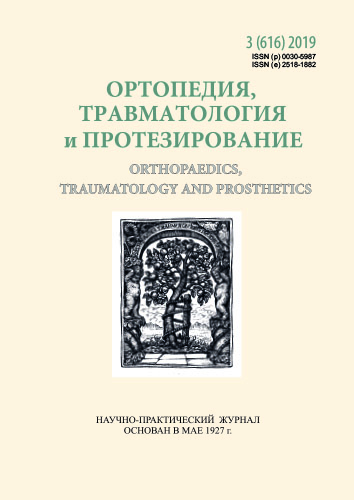Failure of the proximal locking compression plate in treatment of trochanteric femoral fractures
DOI:
https://doi.org/10.15674/0030-5987201935-9Keywords:
proximal femoral fracture, proximal femoral plate, the results of treatmentAbstract
Treatment of proximal femoral fractures constantly draw attention of trauma surgeons because of their greater incidence. Last 10 years, shows the prevalence of intramedullary techniques, however plate osteosynthesis with proximal locking plate is still quite common in everyday practice.
Objective: to conduct a retrospective analysis of treatment results of patients with proximal femoral fractures operated with locking proximal femoral plate and to identify the main mechanisms causing the high rate of unsatisfactory results.
Methods: the study included 21 patients (mean age (65 ± 12) years) with fractures 31А2 and 31А3 according to the AO classification, that undergone osteosynthesis with proximal femoral LCP plate. Mean follow-up period was 7.5 months after surgery.
Results: the absence of displacement and initial consolidation of the fracture was achieved in 17 of 21 patients (80.9 %). The average time of union was 6 months. Unsatisfactory results of treatment were observed in 4 cases (19.1 %). All of them were associated with fracture of the plate and nonunion of bone fragments. The fracture of the plate occurred at the level of the distal 7.3 mm locking hole in 8–9 months after the surgical intervention. In all this cases the revision surgery- implantation of proximal femoral antirotational nail (PFNA) was performed. In our opinion, such a large number of unsatisfactory results associated with excessive rigidity and an undesirable concentration of load.
Conclusions: usage of proximal plates with angular stability of the screws is not always effective for the treatment of unstable fractures of the proximal femur. The high frequency of unsatisfactory results that required re-osteosynthesis with the PFNA, indicates the need for careful preoperative planning and selection of stabilization method for proximal femoral fracture treatment.
References
- Socci, A. R., Casemyr, N. E., Leslie, M. P., & Baumgaertner, M. R. (2017). Implant options for the treatment of intertrochanteric fractures of the hip. The Bone & Joint Journal, 99-B (1), 128–133. doi:10.1302/0301-620x.99b1.bjj-2016-0134.r1
- Chen, F., Wang, Z., & Bhattacharyya, T. (2012). Convergence of outcomes for hip fracture fixation by nails and plates. Clinical Orthopaedics and Related Research, 471 (4), 1349–1355. doi:10.1007/s11999-012-2694-8
- Roberts, K. C., Brox, W. T., Jevsevar, D. S., & Sevarino, K. (2015). Management of hip fractures in the elderly. Journal of the American Academy of Orthopaedic Surgeons, 23 (2), 131–137. doi:10.5435/jaaos-d-14-00432
- Hu, S., & Zhang, G. Yu. (2012). Treatment of femoral subtrochanteric fractures with proximal lateral femur locking plates. Acta Ortopédica Brasileira, 20 (6), 329–33. doi: 10.1590/S1413-78522012000600003.
- Kumar, N., Kataria, H., Yadav, C., Gadagoli, B. S., & Raj, R. (2014). Evaluation of proximal femoral locking plate in unstable extracapsular proximal femoral fractures: Surgical technique & mid term follow up results. Journal of Clinical Orthopaedics and Trauma, 5 (3), 137–145. doi:10.1016/j.jcot.2014.07.009
- Mitchell, E., Kregor, P. (2005). Submuscular locked plating for pertrochanteric femoral fractures. Early experience in a consecutive one-surgeon series. Annual Meeting of the Orthopedic Trauma Association. Phoenix, Arizona.
- Mast, J. (1989). Reduction with Plates. In Mast, J., Jacob, R., Ganz, R. (Ed.). Planning and reduction technique in fracture surgery. Berlin, Germany: Springer-Verlag.
- Zha, G., Chen, Z., Qi, X., & Sun, J. (2011). Treatment of pertrochanteric fractures with a proximal femur locking compression plate. Injury, 42 (11), 1294–1299. doi:10.1016/j.injury.2011.01.030
- He, S., Yan, B., Zhu, J., Huang, X., & Zhao, J. (2018). High failure rate of proximal femoral locking plates in fixation of trochanteric fractures. Journal of Orthopaedic Surgery and Research, 13 (1), 248. doi:10.1186/s13018-018-0951-6
- Streubel, P. N., Moustoukas, M. J., & Obremskey, W. T. (2013). Mechanical failure after locking plate fixation of unstable intertrochanteric femur fractures. Journal of Orthopaedic Trauma, 27 (1), 22–28. doi:10.1097/bot.0b013e318251930d
- Forward, D. P., Doro, C. J., OʼToole, R. V., Kim, H., Floyd, J. C., & Sciadini, M. F. (2012). A biomechanical comparison of a locking plate, a nail, and a 95° angled blade plate for fixation of subtrochanteric femoral fractures. Journal of Orthopaedic Trauma, 26 (6), 334–340. doi:10.1097/bot.0b013e3182254ea3
- Hasenboehler, E. A., Agudelo, J. F., Morgan, S. J., Smith, W. R., Hak, D. J., & Stahel, P. F. (2007). Treatment of complex proximal femoral fractures with the proximal femur locking compression plate. Orthopedics, 30 (8), 618–623.
Downloads
How to Cite
Issue
Section
License
Copyright (c) 2019 Oleksandr Polivoda, Diomyd Chabanenko

This work is licensed under a Creative Commons Attribution 4.0 International License.
The authors retain the right of authorship of their manuscript and pass the journal the right of the first publication of this article, which automatically become available from the date of publication under the terms of Creative Commons Attribution License, which allows others to freely distribute the published manuscript with mandatory linking to authors of the original research and the first publication of this one in this journal.
Authors have the right to enter into a separate supplemental agreement on the additional non-exclusive distribution of manuscript in the form in which it was published by the journal (i.e. to put work in electronic storage of an institution or publish as a part of the book) while maintaining the reference to the first publication of the manuscript in this journal.
The editorial policy of the journal allows authors and encourages manuscript accommodation online (i.e. in storage of an institution or on the personal websites) as before submission of the manuscript to the editorial office, and during its editorial processing because it contributes to productive scientific discussion and positively affects the efficiency and dynamics of the published manuscript citation (see The Effect of Open Access).














